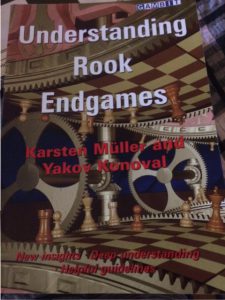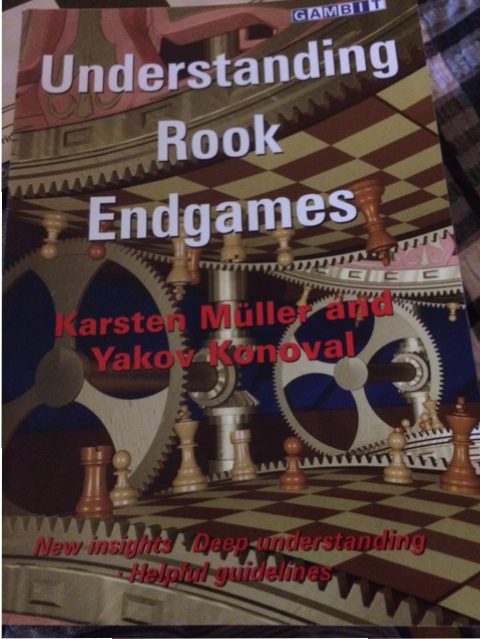I’ve been spending some time looking through Muller and Konoval’s “Understanding Rook Endgames” presents findings about King, Rook & 2 Pawns versus King, Rook & Pawn endings using the latest 7-man tablebases.

One fact that amazed me was that the superior side wins 46% of King, Rook, a & b / g & h Pawns versus King, Rook & a / h Pawn endings. That’s an enormous percentage for an ending you would normally use as a safe haven to liquidate to from an inferior position. I thought it would be interesting to take a look at some of the examples in the book and try to draw some general rules. We’ll focus on a typical situation where both a- / h- pawns are on the 4th rank and the b- / g- pawn is on the 3rd rank (not passed). Something like this:
We can distinguish 4 different defensive techniques for the inferior side. We’ll present them in order from clearest to most fraught!
1. Transposing to a drawn pawn endgame
Some care is required here of course, but the exchange of rooks does not inevitably produce a Black win:
Gustafsson,Jan – Morozevich,Alexander
Dresden Olympiad 2008
75.Rf3+
As Muller points out here
75…Rf4 76.Kg3 Rxf3+ 77.Kxf3 Ke5 78.Ke3
is just a draw
Huang Qian – Stefanova,Antoaneta (variation)
WMSG 2008
75.Ra7+ Rf7 76.Rxf7+ Kxf7 77.Kf4 Kf6 78.Ke4 is also a draw
2. Defend the h-pawn with the king and let the rook harass the g-pawn
This is the most desirable defensive formation:
Gustafsson,Jan – Morozevich,Alexander (variation)
Dresden Olympiad.2008
Here White should have played
70.Kg2 Kf4 71.Rb1 Ra2+ 72.Kh3
with a draw according to Muller
3. Active defence using a stalemate cheapo!
I saw this idea for the first time as a defensive concept in Muller’s book. It’s very neat!
Huang Qian – Stefanova,Antoaneta
WMSG 2008
White seems to be in big trouble as the h-pawn is impossible to defend directly. However, White has a wonderful idea that often crops up in this pawn configuration.
69.Rb6+ Kg7
Now White played 70.Rb7+ and lost 16 moves later. Muller points out:
70.Rb4 Rxh4+ 71.Kg5
which draws as
- 71…Rxb4 is stalemate
- 71…Rg4+ 72.Rxg4 hxg4 73.Kxg4 is a drawn king and pawn ending
- 71…Rh1 72.Rb7+ regains the g-pawn with equality
Amazing!
4. Passive defence using the rook to defend the h-pawn from the h-file
This is not your dream situation, but it’s not necessarily lost! That means it can be either your saving grace in a desperate situation, or the first step on the slippery slope to defeat!
Let’s take a look how it can be the latter! If the superior side (Black in our example) is going to win this type of ending, he has a 5-step plan to achieve it:
- Force the rook to defend the h-pawn from a passive position
- Restrict the movement of the White king and rook
This is the last point at which White can resist. If Black achieves his desired structure displayed in the diagram, then White is lost
- Nudge the White king away from the kingside to allow Black to use the f3,f2,g4,g3 and g2 squares to reposition his pieces
- Force White to launch a desperate counterattack against Black’s g-pawn to avoid losing the h-pawn for no compensation
- Use the remote position of the White king to transpose into a winning King, Rook and h-pawn versus King and Rook ending.
As with so many rook endings, some prior knowledge of K, R & P vs K & R endings is necessary to be able to play an earlier position properly. In this case, we need to make sure we understand the basics of King, Rook and h-pawn versus King and Rook endings. For this, I can best refer you to an earlier blog article – “King, Rook and Pawn vs King and Rook – Part III” – which should give you all you need!
Let’s take a look at how this works using Muller’s analysis of the game Gustafsson – Morozevich to take us through the 5 stages:
Gustafsson,Jan – Morozevich,Alexander
Dresden Olympiad 2008
1. Force the rook to defend the h-pawn from a passive position
66.Kf2 Rg4 67.Kf3 Ke5 68.Rh2 Ra4 69.Rh1
2. Restrict the movement of the White king and rook
69…Ra3+ 70.Ke2
As we showed earlier this was a big mistake. In the game Morozevich didn’t manage to exploit it.
After
70…Ke4 71.Rb1 Rg3 72.Kf2 Rg4 73.Rh1 Kf4
Gustafsson found the excellent move
74.Rh3
Preventing Black’s ideal setup with …Rg3 which allowed him to hold the draw.
74…Kf5 75.Rf3+ Ke5 76.Re3+ Kf6 77.Rf3+ Kg7 78.Rh3 Rb4 79.Rh1 Kf6 80.Kg3 Rb3+ 81.Kf4 Ra3 82.Rh2 Ra4+ 83.Kg3 Rg4+ 84.Kh3 Kf5 85.Ra2 Re4 86.Ra5+ Re5 87.Ra3 Kf4 88.Ra6 Re3+ 89.Kh2 Kf5 90.Ra5+ Re5 91.Ra4 Re4 92.Ra5+ Kg4 93.Rg5+ Kxh4 94.Rxg6 Re2+ 95.Rg2 Rxg2+ 96.Kxg2 Kg4 97.Kh2 h4 98.Kg2 h3+ 99.Kh2 Kh4 100.Kg1 Kg3 101.Kh1 h2 ½–½
Black could however speed things up by one crucial move with Muller’s improvement
70…Rg3 71.Rf1 Rg4 72.Rh1 Kf4 73.Kf2 Rg3
Black is now in time to prevent Rh3. Why is this so important? Well take a look at the waiting moves that White has!
First of all with his rook:
a) 74.Ra1 Kg4 75.Ra4+ (75.Rh1 Rh3 76.Rg1+ Kf5 leaves the h-pawn helpless in the clutches of Black’s rook!) 75…Kh3 followed by …Rg4 encircles the h-pawn!
b) 74.Rh2 Ra3 wins as White can no longer avoid the exchange of rooks in very unfavourable circumstances.
That means that White must move his king, and every king move concedes room for Black’s king to worm his way into the g2 square.
c) 74.Ke2 Rg2+ Chasing the White king further away 75.Kd3 (75.Kf1 Kg3) 75…Rg4 Attacking the g4 pawn and freeing a path for the Black king into g2 76.Kd4 Kg3+ 77.Ke5 Kg2;
That leaves Muller’s best line:
d) 74.Kf1
The winning line isn’t very easy to predict accurately but the idea is clear: keep on nudging the White king out of the way until you get the Black king where you want it!
3. Nudge the White king away from the kingside to allow Black to use the f3,f2,g4,g3 and g2 squares to reposition his pieces
74…Rf3+ 75.Ke2 Kg4 76.Rg1+ Rg3 77.Rh1 Rg2+
clearing g3 for the king
78.Ke3 Kg3 79.Kd3 Kf2
Making way for the rook to come back to g4 attacking h4 so that the king can chase away the White rook with …Kg2! Very delicate manoeuvres!
4.Force White to launch a desperate counterattack against Black’s g-pawn to avoid losing the h-pawn for no compensation
80.Ke4
White launches a desperate counterattack to at least win back the g-pawn for his doomed h-pawn
80…Rg4+ 81.Ke5 Kg3 82.Kf6
White seems to have achieved his goal, but his pieces are very unfortunately placed.
5. Use the remote position of the White king to transpose into a winning King, Rook and h-pawn versus King and Rook ending.
82…Rxh4 83.Rg1+ Kf3 84.Rxg6 (84.Kxg6 Rg4+ wins!) 84…Rg4 85.Rh6 h4
wins (see the earlier blog article – “King, Rook and Pawn vs King and Rook – Part III” for the conclusion of this ending)
Maybe it’s nice though to end this article with an example of how you can use your knowledge of the passive defence scheme to save an otherwise hopeless game. Muller gives this game as an exercise. I think you’ll only find the answer if you’ve just seen the exercise above!
Ree,Hans – Andersson,Ulf
IBM Amsterdam 1979
In the game, White lost quickly:
48.Kd3 Ke5 49.Rc3 Rd4+ 0–1
However, 48.Rc3 is the way to draw!
48…Rxa4 (48…Ke5 49.Ra3
is a draw: the White rook is ideally-placed on a3!) 49.Rb3 Re4+ (49…Rb4 50.Rxb4 axb4 51.Kd3) 50.Kd3 Re6 51.Kc4 Ke4 52.Kb5 Kd4 53.Rh3 Re3 54.Rh4+ Re4 55.Rh3
Certainly not easy in a practical game, but once you know the passive position is a draw, some ideas might just pop into your head!



